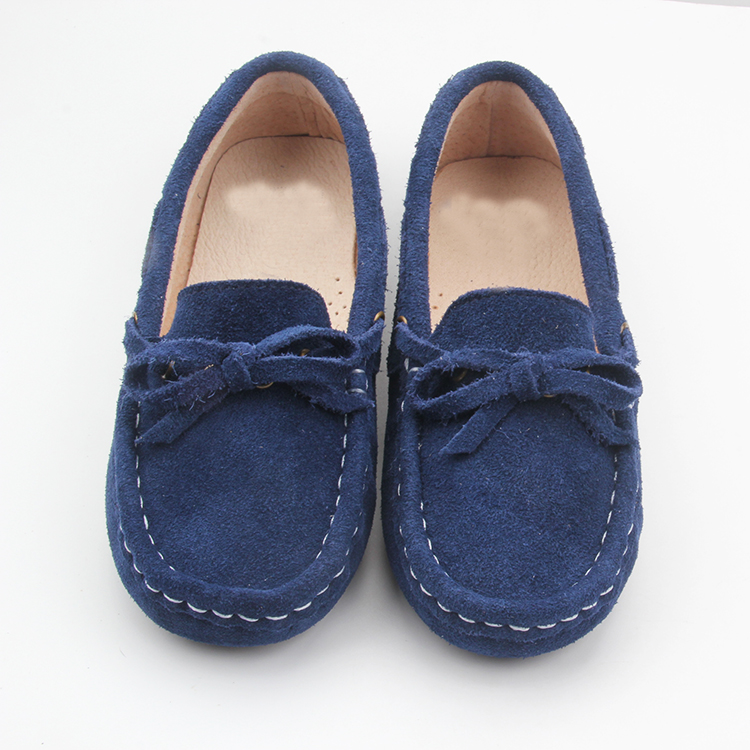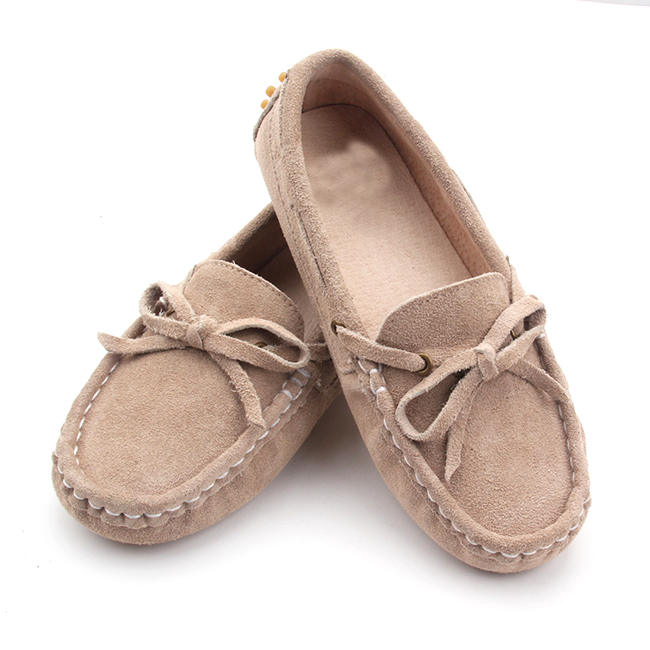Boat shoe
Boat shoes are worn by both women and men.
Boat shoes (also known as deck shoes) are typically canvas or leather with non-marking rubber soles designed for use on a boat. A siping pattern is cut into the soles to provide grip on a wet deck; the leather construction, along with the application of oil, is designed to repel water; and the stitching is highly durable. Boat shoes are traditionally worn without socks.
History
Modern boat shoes were invented in 1935 by American Paul A. Sperry of New Haven, Connecticut after noticing his dog's ability to run easily over ice without slipping. Using a knife, he cut siping into his shoes' soles, inspiring a shoe perfect for boating and a company called Sperry Top-Sider. Sperry Top-Siders are still a popular brand of boat shoe today, among many others, including Sebago and Timberland.
Boat shoes are used by sailors, as the name suggests; however, since the 1970s they have become casual footwear in coastal areas of the United States, Canada, Argentina, Australia, China, France, Italy, Portugal, Spain, and the United Kingdom. Some boat shoes today have traditional white, non-marking soles, though many others today have dark non-marking soles. They usually have a moc-toe (like a moccasin) construction.
In the 1980s through to the early 1990s, and returning in the late 2000s, boat shoes were worn with everyday and dressy wear alike by both boys and girls and men and women. Besides being worn by themselves, many children and adults wear them with socks, especially low-cut, ankle socks and crew in white and many other bright neon and pastel colors. Many schools with uniform requirements allow boat shoes as acceptable uniform shoes.
References
hidevte
Footwear
Men's
dress shoes
Blucher Brogues Brothel creepers Court shoes Derby Monks Oxfords Slip-ons (Loafers) Spectator shoes (Co-respondent shoes) Venetian-style shoes Winklepickers Wholecuts
Women's
dress shoes
Ballet flats Court shoes High-heeled footwear Mary Janes Mojari Mules Peep-toe shoes Saddle shoes Slingbacks Slip-ons (Loafers) Venetian-style shoes Winklepickers
Other shoes
Driving moccasins Flip-flops Galoshes Platform shoes Sandals Self-tying shoes Slides Slippers Veldskoens
Wooden footwear
Bakya British clogs Cantabrian albarcas Clogs Getas Klompen Namaksin Padukas Pattens Sabot Träskor
Military footwear
Ammunition boots Bunny boots Combat boots Jackboots Jump boots Jungle boots Tanker boots Trench boots
Sport-related
footwear
Athletic shoes Ballet shoes Boat shoes Climbing shoes Cross country running shoes Cycling shoes Football boots Ghillies Hiking boots Ice skates Inline skates Jika-tabi Kung fu shoe Minimalist shoes Motorcycle boots Mountaineering boots Plimsolls Racing flats Riding boots Roller shoes Roller skates Safari boots Skate shoes Ski boots Sneakers Swimfins Water shoes Wrestling shoes
Fashion boots
Chelsea boots (Beatle boots) Chukka boots Go-go boots Knee-high boots Over-the-knee boots Platform boots Thigh-high boots Ugg boots
Work boots
Australian work boots Cowboy boots Engineer boots Hip boots Rigger boots Steel-toe boots Waders
Other boots
Jodhpur boots Wellington boots
Traditional
footwear
Abacas Abarkas Alpargatas Avarcas Balghas Bast shoes Clogs Espadrilles Galesh Giveh Haferlschuh Hnyat-phanats Huarache (shoe) Hwas Jorabs Moccasins Mojaris Mukluks Opanaks Peshawari chappals Snowshoes Valenkis Warajis Kolhapuri chappals
Historical footwear
Areni-1 shoes Buskins Caligae Chopines Crakow (Poulaine) Hessians Pampooties Pirate boots Sabatons
Shoe construction
Bespoke shoes Blake construction Goodyear welt
Socks
Anklets Bobby socks Dress socks Footwraps Knee highs Toe socks Tabi
List-Class article List of shoe styles
Stub icon This shoe-related article is a stub. You can help Wikipedia by expanding it.
Kids Boat Shoes,Children Boat Shoes,Casual Leather Shoes,Baby Loafers Shenzhen Baby Happy Industrial Co.,LTD , https://www.babyshoes.cc




Electrostatic flocking fabric into technology
Reporter: "electrostatic flocking fabric efficient flame retardant, waterproof and easy to decontamination complex finishing technical research" is a What kind of technology? Zhao Aiguo: The technical field involved in this project is the technical field of dyeing and finishing. It is a kind of textile functional finishing technology developed for electrostatic flocking fabric products, which can obviously expand the use range of products and enhance the technical performance and economy of the products Added value. Using this technology to process the functionalized flocking fabric can give the flocking fabric efficient flame retardancy, water repellency and easy decontamination properties, making it a widely applicable technology for automobiles, trains, ships (including Senior yachts), aircraft, interior decoration and apparel fabrics, is a high security, easy care, silky feel, colorful, unique style of high-end textile decoration products. The product belongs to both textile products, but also belong to industrial textiles. The technology is environmentally friendly and efficient, easy to operate, stable and reliable quality characteristics. The selection of textile chemical additives are environmentally friendly, high performance halogen-free non-ionic semi-permanent flame retardant, weak positive waterproof and oil repellent, positive and efficient softener and flame retardant coating glue and other green products; In addition, the production The process focus on anti-staining, to protect the health of workers and product recyclability. The technology involves three-step technology processing: the first step, padding chemical functional finishing; the second step, the back coating; the third step, curing curing. The equipment used is: hydraulic tenter combination machine, coating machine, dryer and baking machine. The project technology has independent intellectual property rights. Pleasure Home Textiles has applied to the State Intellectual Property Office for two technological invention patents: "a flocking cloth finishing method" and "a flocking cloth printing method." One "flocking cloth printing method" invention patent application has been authorized by the state, another invention patent is in the trial process, about to obtain the state authorization. This product by the Swiss Clariant (Clariant) company testing, the results show that to IMO (International Maritime Organization), AATCC (American Society of Dyeing and Textile Chemists) standards, the National Fire Equipment Quality Supervision and Inspection Center, in line with national Standard GB50222-95 "fire protection design of interior decoration" decoration materials, fire performance level B1 requirements, while the smoke density and oxygen index, have reached the highest national standards. Reporter: How long does it take to complete the project? Zhao Aiguo: The project lasted for two years from July 2009 to September 2011 and was listed as the 2009 Shandong Provincial Science and Technology Development Project. The project was approved by Shandong Science and Technology Department in November 2011 Provincial scientific and technological achievements appraisal, in the international advanced level, the leading domestic technology. Reporter: Pleasant textile in the capture of the technology encountered what kind of difficulties? Zhao Aiguo: During the development of the project, we encountered more difficulties, mainly due to the technical problems arising from the centralized technology test and development. Specifically, the technical bottlenecks that have emerged in the formulation, testing, and adjustment of technical solutions need to be overcome one by one. For example, there is a certain contradiction between flame retardant effect and fabric feel. If you want a good flame retardant effect, it is bound to increase the number and dosage of flame retardant finishing agent, but this will make the fabric feel harder, which seriously affect the product feel and effect. After the process of formula and selected additives dozens of adjustments and optimization of choice, by increasing the finishing agent concentration, looking for alternatives and other means, we finally better solve this contradiction. There are many technical problems such as this, summed up a successful experience that is relying on our entire technological development team's indomitable patience, teamwork and team work together and the correct scientific method, and ultimately make the project constantly adjusted and improved in full depth Finishing summary and analysis based on the more stable and reliable technical programs, conducted a small batch of trial production and success. Reporter: How the technology will be applied to the textile industry, the benefits of textile products? Zhao Aiguo: At present, this technology has been in our company for industrial applications, the daily product testing, product quality and stability, to meet customer quality requirements. It is proposed to further improve the technology to reduce costs, improve product performance and economic added value and enhance energy-saving emission reduction effect. For home textile products, the need for specific product material, organizational structure and customer quality requirements for technical programs to adjust, including formulations, process routes, so that it can be applied to the needs of textile products. The benefits of this technology for home textile products are to be able to give the product better and more performance, to improve the safety of the product, to facilitate daily care and thereby to be more conducive to consumer use and care. Reporter: How to realize the transformation and upgrading of textile industry through scientific and technological strength? Zhao Aiguo: The "Light of Textile" has both profound and painstaking pioneering historical precipitations and an era of pioneering and innovative spirit in the new era. It is a "propeller for the textile industry to achieve industrial improvement, structural adjustment, transformation of development mode and construction of a textile power "Is the" compass "and" the light of civilization "leading the industry in the direction of scientific and technological progress. The Twelfth Five-year Development Plan of the textile industry and the Twelfth Five-year Development Plan of the textile industry have made it very comprehensive, very detailed and clear about how to achieve the transformation and upgrading of the textile industry. Simply put, it is to rely on technological progress, brand building, marketing innovation, talent support, independent intellectual property rights and sustainable development, and several other ways to achieve. For the enterprise, it is to constantly improve the quality management of the core of the enterprise culture, according to the actual business, closely around the market and consumer trends, in accordance with national industrial policy guidance, based on technological innovation, quality assurance as the guarantee, optimization Product structure, develop new products that meet the needs of the market, strengthen the construction of market terminals, establish the brand of enterprises and products, expand the brand awareness and reputation, enhance the brand value, improve the market response speed, improve the service level, and realize the cooperation with customers, employees and the society Common development, the quality, efficiency and sustainable development as the only guiding ideology and measurement of business development, and resolutely abandon the past simply on the scale, capacity expansion, production and the extensive mode of development in order to achieve the transformation and upgrading of the textile industry.